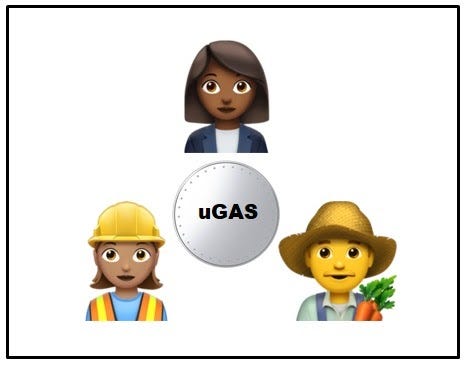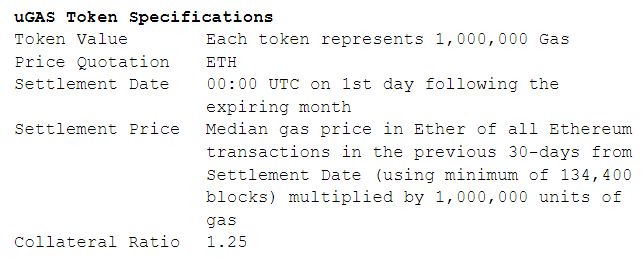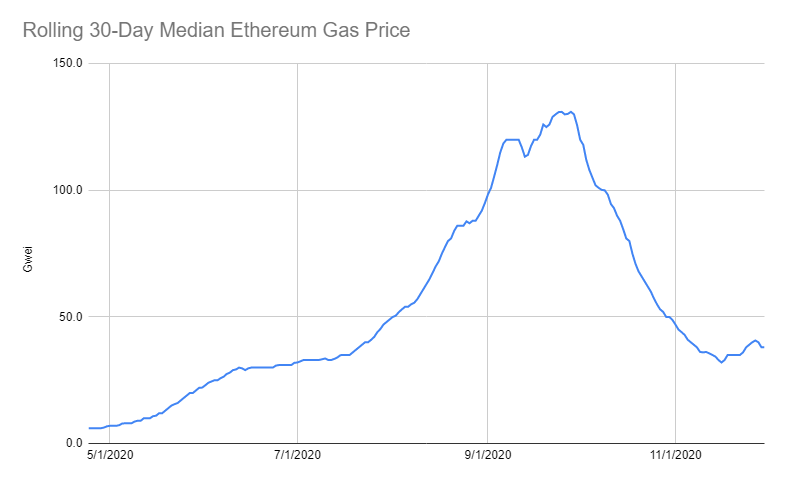Latest news about Bitcoin and all cryptocurrencies. Your daily crypto news habit.

Backdrop
Over the last few weeks uLABS have taken an idea from the community (credit to Ali Atiia) and deployed an UMA contract onto mainnet with little to no help from UMA’s engineering team. Kevin, as a former trader, helped design the token and Sean, with a background in technology consulting, navigated through UMA’s docs to set up and construct the contract. Today they introduce the uGAS token. Watch for their Medium articles over the next few weeks as they document how anybody can take an idea and build on UMA.
Why Gas?
The popularity of DeFi has come with a rise in Ethereum gas prices and a rise in the volatility and uncertainty of this transaction cost. uLABS’ synthetic Gas Futures Token (uGAS) aims to address this problem by allowing “users” and “providers” of gas to lock in their costs or revenue. The uGAS token can act as a hedge for these natural users, but can easily be used as an instrument for speculating on gas prices as well.
Existing contracts such as the Gas Token and the Chi Gas Token provide a partial solution to this issue. However, they do not allow for pure hedging or speculation, and may be too complex for the average crypto participant. UMA’s approach is very different and borrows concepts from the proven futures markets of the traditional finance world. uGAS tokens are designed and used in a similar way to futures contracts on crude oil, gold, or Fed Funds.
What is uGAS?
The uGAS-JAN21 token will settle with the median gas price of all Ethereum transactions in January (30-days is the actual specification). With a simple contract like this, market participants can effectively buy or sell the contract today and lock in the median gas price in Gwei for the month of January now. You can create and redeem these tokens at the uGAS Station.
How do we use uGAS?
The best way to understand how uGAS works is to walk through some detailed examples with natural buyers and sellers.
Alex the Trader
Alex is a trader who believes ETH Gas prices will rise in January and decides to buy the uGAS-JAN21 token. She connects her wallet to Uniswap and prepares to buy 100 uGAS-JAN21 with her ETH.
The price on the user interface shows 1 uGAS-JAN21 = 0.070 ETH. This effectively means Alex is getting long ETH Gas prices at 70 Gwei. To further clarify this, each token represents 1,000,000 Gas and 1,000,000,000 GWei equals 1 Ether. Ignoring transaction costs, she would need to sell 7 ETH to buy 100 uGAS-JAN21 tokens.
Expectations for ETH Gas prices rise and the uGAS-JAN21 token can now be exchanged for 0.100 ETH per token (equivalent to 100 Gwei). Alex sells her 100 uGAS-DEC20 tokens and receives 10 ETH in return for a profit of 3 ETH (or 0.03 ETH per token or 30 Gwei on 1 million units of gas)
Brad the Farmer
Brad is an active farmer who carries out many transactions to manage his crypto portfolio. It is early December and he sees the uGAS-JAN21 token trading at 70 GWei and would like to lock in that price for his gas usage in the month of January.
Brad does the equivalent of 10,000 simple transactions (21,000 gas) per month which translates to 210,000,000 gas (10,000 transactions x 21,000 gas / transaction)
Given each uGAS token is equivalent to 1,000,000 gas, to fully hedge his usage, Brad would need to buy 210 uGAS-JAN21 tokens (210,000,000 gas / 1,000,000 gas per token)
Brad connects his wallet to Uniswap and finds 1 uGAS-JAN21 = 0.070 ETH (equivalent to 70 Gwei). Ignoring transaction costs, he would need to sell 14.7 ETH to buy 210 uGAS-JAN21 tokens.
Brad continues his farming activity per usual in the month of January and consumes 210,000,000 gas by the end of the month as expected. However, he paid on average 105 GWei on the price of gas for all these transactions in January which is much higher than where he saw gas prices in early December.
Brad held onto his 210 uGAS-JAN21 tokens through the token expiry at 00:00 UTC February 1, 2021. The 30-day median ETH Gas price prior to that day (which is the majority of the month of January 2021) is 110 Gwei and the token expires at this price.
Brad can now redeem each uGAS-JAN21 token for 0.110 ETH. After doing this he receives 23.1 ETH — a profit of 8.4 ETH (or 0.04 ETH per token or 40 Gwei on 1 million gas). However, this profit of 8.4 ETH is offset by the higher gas prices he paid in January. Effectively, Brad used the uGAS-JAN21 token as a hedge for rising ETH gas prices.
Clare the Miner
Clare runs an Ethereum mining operation. The uGAS-JAN21 token is trading at 70 Gwei. She believes that ETH gas prices will decline in the next two months and would like to use the token as a hedge and secure her future revenues now.
Clare mines the equivalent of 50,000 simple transactions (21,000 gas) per month which translates to 1,050,000,000 gas (50,000 transactions x 21,000 gas / transaction)
Given each uGAS token is equivalent to 1,000,000 gas, to fully hedge her mining revenue, Clare would need to mint and then sell 1,050 uGAS-JAN21 tokens (1,050,000,000 gas / 1,000,000 gas per token)
Clare connects her wallet to the uGAS Station and selects uGAS-JAN21. She clicks on “Manage Position”, selects “Create — Mint new synthetic tokens.” Under “Tokens (uGAS-JAN21)” she enters “1,050” and then under “Collateral (WETH)” she presses “MIN”. With the Global Collateral Ratio (GCR) at 2.5, the resulting number is 183.75 WETH (2.5 x 1,050 tokens x 0.070 ETH per token). Clare clicks “Create” and mints 1,050 uGAS-DEC20 tokens while depositing 183.75 WETH. Note that the Collateral Ratio for the token is 1.25 so she can currently withdraw collateral without fear of liquidation given she is well collateralized at a ratio of 2.50.
Clare then connects her wallet to Uniswap and sells her 1,050 uGAS-JAN21 tokens at a price of 0.070 ETH each (equivalent to 70 Gwei) and receives 73.5 ETH. Notice that net Clare is now committing 110.25 ETH (183.75 of WETH Collateral — 73.5 ETH received). And she could withdraw more collateral to be more capital efficient as long as she maintains her 1.25 collateral ratio.
Unfortunately, ETH gas prices rise and the median price for the last 30 days of January is 110 Gwei — resulting in the uGAS-JAN21 token settling at 0.110. Clare takes a loss of 42 ETH (1,050 tokens x (0.070–0.110)). However, the higher gas prices in January resulted in higher revenues for her mining operation which offset the loss from her tokens. In the end, the uGAS token hedge resulted in Clare locking her mining revenues at 70 Gwei and provided her with certainty on her revenue amount.
Token Sponsors and Collateral
The uGAS token uses a new approach to monitoring collateralization ratios in comparison to existing tokens created with the EMP contract. Prior tokens use an independent price source to ensure the value of the token is collateralized. The unique and backward looking design of the 30-day median gas price identifier creates two challenges. First, there is no independent price source for forward looking 30-day median gas prices and second, the use of a rolling 30-day median gas price for collateralizing a forward looking token could expose it to under collateralization and exploitation. We designed a special price identifier approved in UMIP 20 that allows uGAS to use the 2-hour time weighted average price (TWAP) of the uGAS token itself to monitor collateral ratios. The uGAS token acts as the best forward expectation of the final 30-day median gas price settlement and a 2-hour TWAP is chosen to protect against manipulation.
Developer Mining and dApp Mining
In addition to being a useful product for the ETH community, uLABS’ intention with uGAS is to provide an example for how anybody can use UMA’s developer mining program to reward users of their product and incentivize others to build alongside them.
Developers do have the freedom to keep the UMA tokens they receive for themselves; however, uLABS will choose to pass all these tokens to the community. To reward early participants and aid in liquidity, uLABS will initially grant all earned UMA tokens to liquidity providers who both mint AND pool uGAS-JAN21 (along with WETH) on Uniswap for two weeks from December 3rd to 17th. Farmers who have participated in UMA’s initial liquidity mining program should take note that this works differently. For the original program, farmers needed only to hold BPT tokens for the associated pool, and thus could mint or buy the synth. One of our learnings from this pilot was that rewarding liquidity in this way affects the trading price. For uGAS, rewards are only given to LPs who have minted their own synths.
This should deepen liquidity without impacting the price of the synth. Given the uGAS token will have natural buyers and sellers for hedging purposes, we want to minimize price distortions from liquidity mining and believe this more stringent requirement for allocating rewards may help. After the first two weeks, we will assess the token’s behaviour and liquidity before proceeding further with any mining program. Ideally uLABS would like to pass all developer mining rewards to incentivize the creation of dApps and infrastructure to support uGAS, but we could see a transition in between where we reward some portion to liquidity providers and reserve some portion to developers supporting uGAS in the future. Ultimately we would like members of the community to take ownership of this project.
Conclusion
The uGAS token is a simple way for traders to speculate and for ETH blockchain users and miners to hedge their operations. We hope the token will be well received and would like to create a series of these tokens in the near future if feedback is strong. Please provide us with any and all feedback — good or bad — to help us improve and refine this product. We believe the uGAS token will help the ETH community better manage their transaction fees and help to dampen volatility in gas prices.
Warning: This is an experimental token — users should proceed with extreme caution. Although the EMP contract has been audited in detail by OpenZeppelin, the application of this contract on a volatile price identifier such as Ethereum gas prices is novel and unpredictable in a live market. Users should take time to understand the token and ask questions on the UMA Discord.
Resources and References
uGAS Station, uGAS-JAN21 on Uniswap
uGAS-JAN21 token address, uGAS-JAN21 contract
uGAS-JAN21 2hr TWAP, 30-Day Rolling Median Gas Price , Historical Daily 30-Day Rolling Median Gas Price Data
uLABS Gas Futures Token was originally published in UMA Project on Medium, where people are continuing the conversation by highlighting and responding to this story.
Disclaimer
The views and opinions expressed in this article are solely those of the authors and do not reflect the views of Bitcoin Insider. Every investment and trading move involves risk - this is especially true for cryptocurrencies given their volatility. We strongly advise our readers to conduct their own research when making a decision.




